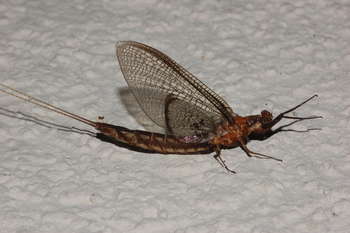Massive mayfly swarms a good sign!

Mayflies swarming under light
Photo: Danielle Hartung
On July 22, a massive swarm of mayflies occurred near Redwing, MN, which contributed to a three-car crash on the Hwy 63 Bridge over the Mississippi River to Hager City, WI. The crash happened when the swarm of mayflies created blizzard like conditions and the bridge and the bridge deck became extra slick due to crushed mayflies. This mass emergence or hatch of mayflies was so big that it appeared on radar. Because of incidents like this, mayflies have acquired a bad reputation. Although they can be a nuisance, mayflies are also a sign of good things for the river and its ecosystem, and it is wonderful that they are back.
Mayflies, or shadflies as some call them, are an indicator of water quality because of their sensitivity to toxins, anoxia (low dissolved oxygen levels in water), and other stresses throughout the year. The fact that they are swarming again is evidence that water quality has improved through efforts eliminating sewage overflows to the river and better treatment systems for waste water.
Mayflies are really interesting little buggers. According to the late Winona State University biology professor Calvin Fremling, there are 625 species living in the US and Canada that emerge at different times throughout the summer. Members of the genus have been around since before the dinosaurs, surviving many extinction events. For thousands of years, they have been living out their life cycles on the Upper Mississippi River System. They spend most of their lives (one year) as aquatic nymphs with feathered gills that live in burrows in the river bottom. Once they develop wings, their sole purpose is to mate and lay eggs to reproduce, which most adults do in a day or two before dying. Because of their short lives, mayflies dont have mouthparts or digestive tracts. The digestive tracts of females become modified into air bladders to help them float on the waterthats why they pop when stepped on!
Only two of the 625 mayfly species are notorious for swarming. They are Hexagenia bilineata and H. limbata. When river temperatures reach 66 degrees F, the winged and dark colored H. bilineata emerge, shedding their skins at the waters surface (subimago stage), and later molt into a fully developed adult (imago stage). Mayflies are the only insects to molt as winged adults.
Believe it or not, we are indirectly setting up mayflies to swarm over asphalt roadways. It turns out that the sky above roads provides a good swarming place because its open and because mayfly females are easily detectable to males, since they are detected by males visually and captured from below. Also, above asphalt roads, the polarization of light at sunset mimics a water surface. Lastly, air temperature above roads at sunset is higher than the surroundings. We are in essence attracting them to swarm over our roadways!
Mayflies are vital links in the foodchain. Nymphs convert non-living organic material into high-quality food for fish and water fowl. They have long life cycles that make them available during all seasons. They molt 20 to 30 times, which provides a variety of food sizes for a variety of critters. The nymphs, adults, and eggs are irresistible food for all kinds of predators. Catfish, for example, stuff themselves during swarms. The strategy of mass emergence is to overwhelm their predators, giving them a better chance to mate and reproduce. They emerge at night perhaps to avoid predation by birds. Also, since the chances of a newly hatched nymph of ever reaching adulthood and reproducing is extremely poor, they increase their odds by producing millions.

Hexagenia bilineata mayfly adult (imago stage)
Photo: John Pickering
Hopefully, now you can see that mayflies, instead of being disgusting and terrible little creatures are actually fascinating and beneficial organisms, and are just doing what comes naturally. As long as we keep seeing swarms of mayflies, we know the river isnt as polluted as it used to be.